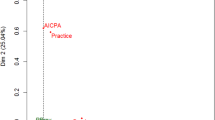Abstract
In recent years, Japanese and American societies have been beset by massive corporate scandals involving accounting firms and their certified public accountants (CPAs). These scandals included major accounting frauds by CPAs and have led to deep distrust of corporate accounting in both societies. This paper provides a detailed probe into three major financial scandals in Japan and United States: Enron, Kanebo, and Livedoor. Case histories are used to highlight both the characteristics of frauds perpetrated by CPAs as well as the social reactions to these economic crimes in Japan and the US. Finally, the paper outlines similarities and differences in CPA frauds perpetrated in both countries and considers how cultural variations play a major role in producing these outcomes.
Similar content being viewed by others
References
Brewster, M. (2003). Unaccountable: How the Accounting Profession Forfeited a Public Trust. Hoboken, New Jersey: Wiley.
Ethics, B. (2002). Reforming Corporate Governance after Enron. July/August: Business Ethics. 6.
Chiyoda, K. (2006). Gendai-Kaikei-Kansaron (Contemporary Auditing). Tokyo: Zeimukeirikyokai.
Editorial Office of the Company History of Kanebo, Ltd. (1988). Kanebo Hyakunen-Shi (One Hundred Years’ History of Kanebo). Osaka: Kanebo.
Friedrichs, D. O. (2004). Trusted Criminals: White Collar Crime in Contemporary Society (2nd ed.). Belmont, CA: Wadsworth.
Green, G. S. (1997). Occupational Crime. Chicago: Nelson-Hall.
Hamada, Y. (2008). Kaikei-Fusei: Kaisha no ‘Joshiki’ Kansanin no ‘Ronri’ (Accounting Fraud: Corporate ‘Common Practice’ and Accounting Auditor’s ‘Logic’). Tokyo: Nihon Keizai Shimbun Shuppansha.
Hayabusa, N. (2006). Kigyo-Sukyandaru to Kansa-Houjin: Naze Fushoji wa Zokuhatsu surunoka (Corporate Scandals and Auditing Firm: Why a Succession of Scandals Occurred). Tokyo: Sairyusha.
Hilzenrath, David S. (2001, December 6). Auditors Face Scant Discipline: Review Process Lacks Resources, Coordination, Will. The Washington Post, p. A1.
Horie, T. (2003). Hyakuoku-Kasegu-Shigoto-Jutsu (How to Make 10 Billion Yen in Your Job). Tokyo: SoftBank.
Horie, T. (2009). Tettei-Kousen (All-Out Resistance). Tokyo: Shueisha.
Hosono, Yuji (2008). Houtei-Kaikeigaku vs. Funshoku-Kessan (Forensic Accounting vs. Window-Dressing Accountings). Tokyo: Nikkei BP.
Ibata, K. (2008). Saikin no Funshoku: Sono Jittai to Hakkenhou (Recent Window Dressing: Its Realities and Detection Methods) (2nd ed.). Tokyo: Zeimukeirikyokai.
Labaton, Stephen. (2002, January 18). S.E.C. Leader Sees Outside Monitors for Auditing Firms. The New York Times, p. A1.
Lane, C. (2005, June 1). Justices Overturn Andersen Conviction: Advice to Enron Jury on Accountants’ Intent Is Faulted. The Washington Post, p. A1.
Mills, Q. D. (2003). Wheel, Deal, and Steal: Deceptive Accounting, Deceitful CEOs, and Ineffective Reforms. Upper Saddle River, New Jersey: FT.
Nomura, Shu (2007, March 17–18). The Biggest Crime in the Livedoor Fiasco? Repeatedly Betraying Investors. International Herald Tribune/The Asahi Shimbun, p. 21.
Okumura, H. (2006). Funshoku-Shihonshugi: Enron to Livedoor (Fraudulent Capitalism: Enron and Livedoor). Tokyo: Toyokeizaishinpo.
Reuters (2008, January 29). Accountant and S.E.C. Reach Deal in Enron Case. The New York Times, p. 6.
Shibata, H. (2007). Funshoku no Kansa-Fudo: Naze, Funshoku-Kessan wa nakunaranainoka (Fraudulent Audit Culture: Why We Cannot Stop Window-Dressing Accountings). Tokyo: Progres.
Squires, S. E., Smith, C. J., McDougall, L., & Yeack, W. R. (2003). Inside Arthur Andersen: Shifting Values, Unexpected Consequences. Upper Saddle River, New Jersey: FT.
Suda, K. (2007). Funshoku-Kessan to Kaikei-Sousa no Shosou (Aspects of Window-Dressing Accounting and Accounting Manipulation). In K. Suda, T. Yamamoto, & S. Otomasa (Eds.), Kaikei-Sousa: Sono Jittai to Shikibetsuhou, Kabuka eno Eikyou (Accounting Manipulation: Its Realities, Identification, and Influence on Stock Prices) (pp. 2–58). Tokyo: Diamond.
Takahashi, A. (2006). Funshoku no Ronri (Logic behind Window Dressing). Tokyo: Toyokeizaishinpo.
Tanaka, S. (2006). Livedoor-Kansanin no Kokuhaku: Watashi wa naze Funshoku-Kessan o Tomerare-nakattanoka (A Confession by Livedoor’s Auditor: Why I Could Not Stop Window-Dressing Accountings). Tokyo: Diamond.
The Asahi Shimbun (2005, October 3). Fusei-Kanshi, Uchinaru-Kabe: Nareai Amai-Naibu-Kansa: Kanebo-Funshoku (Inner Barrier to Fraud Monitoring: Overly Friendly Relations and Lax Internal Audits: Window Dressing in Kanebo). The Asahi Shimbun (evening edition), p. 15.
The Asahi Shimbun (2006a, March 28). Former Kanebo Executives Convicted. International Herald Tribune/The Asahi Shimbun, p. 25.
The Asahi Shimbun (2006b, May 11). ChuoAoyama to Clear Out Bosses. International Herald Tribune/The Asahi Shimbun, p. 25.
The Asahi Shimbun (2006c, August 10). 3 Found Guilty in Scandal Over Dodgy Audit at Kanebo. International Herald Tribune/The Asahi Shimbun, p. 23.
The Asahi Shimbun (2007a, March 17–18). Horie Gets 2½-Year Prison Sentence. International Herald Tribune/The Asahi Shimbun, p. 21.
The Asahi Shimbun (2007b, March 23). Miyauchi Gets 20 Months for Livedoor Scam. International Herald Tribune/The Asahi Shimbun, p. 25.
The Asahi Shimbun (2007c, March 24–25). Livedoor Auditor Handed Prison Term. International Herald Tribune/The Asahi Shimbun, p. 22.
The Asahi Shimbun (2008a, July 25). Horie-Hikoku Nishin mo Jikkei: Tokyo Kosai Hanketsu: Funshoku “Komyo de Akushitsu” (Accused Horie Given Prison Sentence Again in Appeal Trial: Tokyo High Court Decision: Window Dressing Was “Artful and Malicious”). The Asahi Shimbun (evening edition), p. 1.
The Asahi Shimbun (2008b, September 19). Livedoor Funshoku-Kessan Jiken: Moto-Kaikeishi ni Shikko-Yuyo: Tokyo Kosai Hanketsu (Livedoor Window-Dressing Accounting Case: Suspended Sentence against Ex-Accountant: Tokyo High Court Decision). The Asahi Shimbun (evening edition), p. 14.
The Financial Services Agency (2006). The Minutes of the 11th Meeting of the Committee on CPAs System of the Financial System Council. Tokyo: the Planning and Coordination Bureau of the Financial Services Agency.
The Japanese Institute of Certified Public Accountants. (2005). Corporate Disclosure in Japan: Auditing. Tokyo: The Japanese Institute of Certified Public Accountants.
The Nihon Keizai Shimbun (2007, February 27). Kansa-Houjin: Funshoku-Kanyo ni Kachokin (Auditing Firms: Surcharge on Those Involved in Window Dressing). The Nihon Keizai Shimbun (evening edition), p. 1.
Wells, J. T. (1993). Accountancy and White-Collar Crime. The ANNALS of the American Academy of Political and Social Science, 525(1), 83–94.
Yamamoto, S. (1983). ‘Kuki’ no Kenkyu (The Study of ‘Air’). Tokyo: Bungeishunju.
Acknowledgments
The author wishes to express his sincere thanks to Professors Henry Pontell and Gilbert Geis for their kind assistance.
Author information
Authors and Affiliations
Corresponding author
Rights and permissions
About this article
Cite this article
Konishi, T. Fraud by Certified Public Accountants in Japan and the United States. Asian Criminology 5, 99–107 (2010). https://doi.org/10.1007/s11417-010-9089-0
Received:
Accepted:
Published:
Issue Date:
DOI: https://doi.org/10.1007/s11417-010-9089-0




